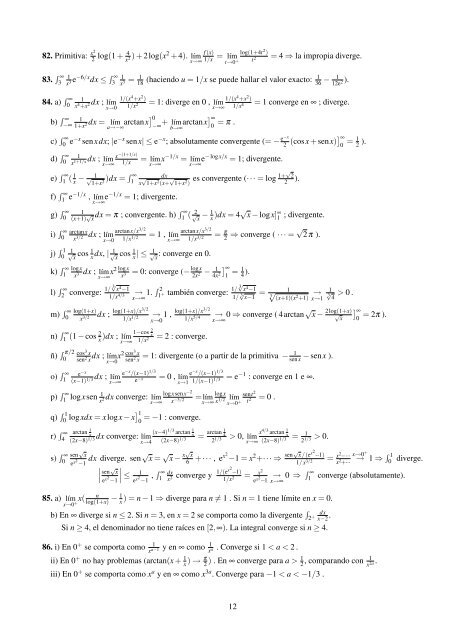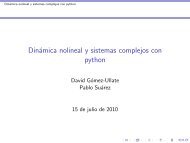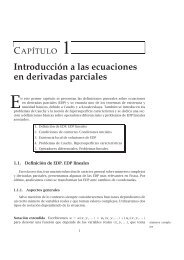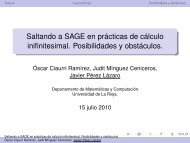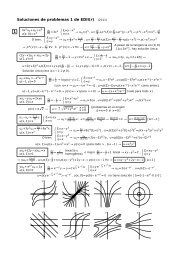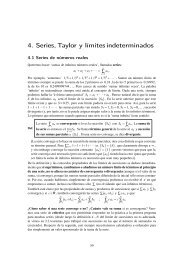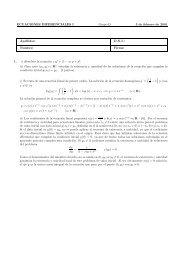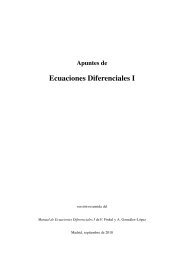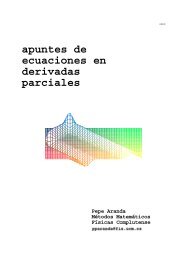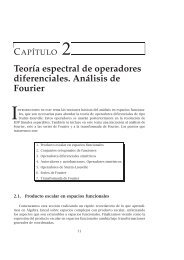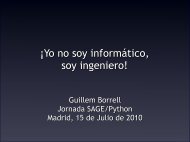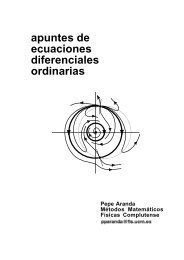1. a) Si x ⥠2, numerador y denominador son ⥠0 , si x < â2
1. a) Si x ⥠2, numerador y denominador son ⥠0 , si x < â2
1. a) Si x ⥠2, numerador y denominador son ⥠0 , si x < â2
- No tags were found...
Create successful ePaper yourself
Turn your PDF publications into a flip-book with our unique Google optimized e-Paper software.
82. Primitiva: x22 log(1+ 4 )+2log(x 2 f(x)+ 4).x 2 límx→∞ 1/x = lím log(1+4t 2 )= 4 ⇒ la impropia diverge.t→0 + t 283. ∫ ∞384. a) ∫ ∞01e −6/x dx ≤ ∫ ∞ 1x 3 3 = 11x 3 18(haciendo u = 1/x se puede hallar el valor exacto:36 − 1 ).12e 21x 4 +x 2 dx ; límx→01/(x 4 +x 2 )1/x 2 = 1: diverge en 0 , límx→∞1/(x 4 +x 2 )1/x 4 = 1 converge en ∞ ; diverge.b) ∫ ∞−∞ 11+x 2 dx = líma→−∞ arctanx] 0−∞ + límb→∞ arctanx] ∞0 = π .c) ∫ ∞0 e−x senxdx; |e −x senx| ≤ e −x ; absolutamente convergente (= − e−x2 (cosx+senx)] ∞0 = 1 2 ).d) ∫ ∞01xdx ; lím−(1+1/x)x 1+1/x x→∞ 1/x= límx −1/x = líme −logx/x = 1; divergente.x→∞ x→∞e) ∫ ∞1 ( 1 x − √ 1 )dx = ∫ ∞ dx1+x 2 1 x √ 1+x 2 (x+ √ es convergente (··· = log 1+√ 21+x 2 ) 2).f) ∫ ∞1 e−1/x , límx→∞e −1/x = 1; divergente.g) ∫ ∞0i) ∫ ∞1(x+1) √ x dx = π ; convergente. h) ∫ ∞1 ( √ 2 x− 1 x )dx = 4√ x − logx] ∞ 1 ; divergente.0 arctanxx 3/2dx ; límx→0arctanx/x 3/21/x 1/2 = 1 , límx→∞arctanx/x 3/21/x 3/2 = π 2 ⇒ converge ( ··· = √ 2π ).j) ∫ 10 1 √ xcos 1 x dx, | 1 √ xcos 1 x | ≤ 1 √ x: converge en 0.k) ∫ ∞1logxdx ;x 3 límx 2 logx= 0: converge (− logx − 1 ] ∞x→∞ x 32x 2 4x 2 1 = 1 4 ).l) ∫ ∞2 converge: 1/ 3√ x 4 −11/x 4/3 →x→∞<strong>1.</strong> ∫ 21 + también converge: 1/ 3√ x 4 −11/ 3√ x−1 = 13√(x+1)(x 2 +1) →x→1m) ∫ ∞013√4> 0 .log(1+x)dx ; log(1+x)/x3/2 → 1 , log(1+x)/x3/2 → 0 ⇒ converge ( 4arctan √ x − 2log(1+x) ] ∞x 3/21/x 1/2 x→0 1/x 5/4 √x→∞ x 0n) ∫ ∞1 (1 − cos 2 1−cosx)dx ; lím2 x= 2 : converge.x→∞ 1/x 2ñ) ∫ π/20o) ∫ ∞1cos 3 xdx ;sen 2 límx x→0 x2 cos3 x1= 1: divergente (o a partir de la primitiva −sen 2 x senx− senx ).e −xedx ; lím−x /(x−1) 1/3e(x−1) 1/3 x→∞ e= 0 , −x lím−x /(x−1) 1/3= e −1 : converge en 1 e ∞.x→1 1/(x−1) 1/3p) ∫ ∞1 logxsen 1 logxsenxdx converge:x 2 lím−2 logx sent= lím lím2= 0 .x→∞ x −3/2 x→∞ x 1/2 x→0 + t 2q) ∫ 10 logxdx = xlogx − x] 1= −1 : converge.0r) ∫ ∞4s) ∫ ∞085. a) límarctan 1 x(x−4)dx converge: lím1/3 arctan 1(2x−8) 1/3 x= arctan 1x→4 (2x−8) 1/3 4x> 0, lím4/3 arctan 12 1/3 x= 1 > 0.x→∞ (2x−8) 1/3 2 1/3sen √ xdx diverge. sen√ x = √ x − x√ xe x2 −1 6 + ··· , ex2 −1 = x 2 +··· ⇒ sen√ x/(e x2 −1)∣ sen√ x∣ ≤ 1 , ∫ ∞e x2 −1 e x2 −1 1 dx converge y 1/(ex2 −1)= x2x 2 1/x 2 e x2 −1x→0 +x(nlog(1+x) − 1 x= x2 −···1/x 3/2 x 2 +···) = n − 1 ⇒ diverge para n ≠ 1 . <strong>Si</strong> n = 1 tiene límite en x = 0.b) En ∞ diverge <strong>si</strong> n ≤ 2. <strong>Si</strong> n = 3, en x = 2 se comporta como la divergente ∫ 2 + dxx−2 .<strong>Si</strong> n ≥ 4, el <strong>denominador</strong> no tiene raíces en [2,∞). La integral converge <strong>si</strong> n ≥ 4.= 2π ).x→0 +→ 1 ⇒ ∫ 10 diverge.→ 0 ⇒ ∫ ∞x→∞1 converge (absolutamente).86. i) En 0 + se comporta como 1 y en ∞ como 1 x a−1 x. Converge <strong>si</strong> 1 < a < 2 .aii) En 0 + no hay problemas (arctan(x+ 1 x ) → π 2 ) . En ∞ converge para a > 1 12, comparando con .x 2aiii) En 0 + se comporta como x a y en ∞ como x 3a . Converge para −1 < a < −1/3 .12


